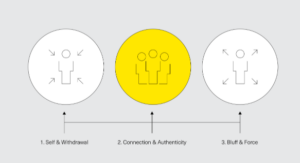How can we help?
Thank you for your enquiry, we will be in touch.
Oops! We could not locate your form.
Thank you for your enquiry, we will be in touch.
Oops! We could not locate your form.
When people find out that I was a professional actor, the first thing they’ll ask – after “What were you in?", is “What do acting and presenting have in common?”
Truth be told, there’s a lot that each can learn from each other – and a lot that each needs to unlearn from the other. And while 15 years of acting has definitely helped my presentation skills, I’m here to tell you something really important: presenting isn’t acting. And you don’t need to be a good actor to be great at presenting.
Ham acting is ham presenting
In my experience, great acting isn’t about ‘acting a part’, but rather being a character. And presenting is about being authentically you, too.
One of the problems with new presenters is that they think they need to ‘act’ the part of a presenter – which tends to mean lots of gesturing, adopting a new personality, or being someone other than themselves. But the opposite is true!
Master vocal coach, author and theatre practitioner Patsy Rodenburg – who’s coached the likes of Dame Judi Dench, Sir Ian McKellan, and Hugh Jackman – has a brilliant model for describing how we engage our audiences.

Rodenburg’s circles
Rodenburg’s first circle is called Self and Withdrawal. You’ll be here if you’re nervous or uncertain about your work. This is the quiet, mumbling, timid presenter who looks at their feet.
Let’s skip to the third circle: Bluff and Force. This is the space of the bad actor – hammy and over the top, over-gesturing at the audience, strutting like a peacock, and generally forcing themselves outwards. It’s got nothing to do with confidence. If you think acting and presenting is all about being an extrovert, then this is where you’ll end up.
Between these two circles is the energy of Authenticity and Connection – presenting with your audience, not just to them. It means matching their energy. It’s courageous, humble, and diligently-prepared. But most importantly, it’s authentic to you as a presenter and to your audience as people you’re there to inspire, not entertain (if you do end up entertaining, then it’s a great bonus!).
Know your stuff, prepare well, and be authentic in your presenting – and you’ll naturally find your way to that powerful connecting state. The most interesting and persuasive presenters deliver their message in a way that feels like a conversation, rather than a performance. They own who they are. They seem comfortable in their skin. And the best part? Their message resonates and lingers long after the encounter because it’s relevant.
So ditch the “character”
And be the real you. Your audience will thank you for it.
For more support in acting authentically you, talk to me about my programmes.
Keep up to date with the latest tips and resources by joining our mailing list.
Spotlight: Fundamentals of Business Presenting
Find out more. Hurry, only 1 spot left!